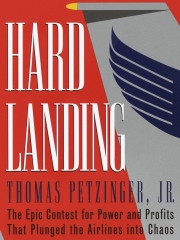Hard Landing by Thomas Petzinger
The airline industry has always fascinated me. For three years, I got an up-close look at its glamours and foibles. From pricing, to routing, to frequent flyer programs, to the fundamental technology, to bailouts, there is no shortage of fodder for discussion. While flying has become a mundane part of (pre-covid) life, every takeoff still holds a certain mystique that makes life just a bit more exciting.
1) Charles Lindbergh started his career as a barnstormer.
Then he flew airmail between St. Louis and Chicago, before achieving world fame by flying between New York and Paris.
2) In 1930, the Post Master General hosted the “Spoils Conference” that allocated mail routes and gave birth to the Big Four airlines.
United controlled the north routes through Chicago, TWA the center routes through St. Louis, American the southern routes through Dallas, and Eastern the north-south routes on the east coast.
3) Southwest was threatened for operating out of Dallas Love Field.
However, the language on the municipal bonds funding the construction of DFW used the word “certified airlines.” Southwest was not a certified airline and continued to operate out of Love Field. Playing into its brand image, Southwest made its ticker symbol LUV.
4) Airlines had a mutual aid pact in which participating airlines would chip in to help an airline under strike.
What a crazy concept. At one point, Lorenzo said that he needed a strike.
5) Under Lorenzo, Texas International launched 50% off “Peanut Fares.”
Pre-deregulation, cross-state fares had been heavily regulated, and the birth of peanut fares was a stark deviation from norms.
6) American’s SABRE booking system nudged travel agents to book American Airlines flights, even when better alternatives were available.
American noticed that travel agents were much more likely to book the first result. The airline thus pushed other results to the bottom or just didn’t show them at all. Is this the early Google?
7) Los Conquistadores del Cielo is an exclusive club of airline executives.
An all-boys club that meets in Wyoming. The story writes itself.
8) In 1981, 13K air traffic controllers went on strike and were fired by Reagan.
This was a major turning point for union power. If I took anything away from this book, it’s the pivotal role unions played in the success and failure of airlines. Nowadays, unions seem powerless.
9) In the early 1980s, American implemented b-scales, meaning that new pilots and flight attendants would be paid less than their counterparts who had joined earlier.
Over time, the average labor cost would thus go down. This policy was especially successful early on because the majority of employees were not b-scale and were thus unaffected.
10) United owned Westin, Hilton, and Hertz at various points in history.
The parent company renamed itself to Allegis and tried to play as a broader travel company. United employees revolted and attempted a buyout. Ultimately, United sold off all non-airline subsidiaries.
It was really difficult to keep track of everything in this book. There were so many CEOs that jumped ship back and forth, and dozens of airlines that went in and out of mergers. That said, I enjoyed learning more about the history of all these airlines. I now have more perspective on why things are the way they are. Why does every American flight route through Dallas? Why does Southwest do non-assigned seating? This book was written in 1996, and so much has happened since. 9/11, 2008, COVID. The post script included an especially anachronistic discussion on how the internet might decrease flight demand. It goes to show that no one can predict anything, other than the fact that your flight will be delayed.
